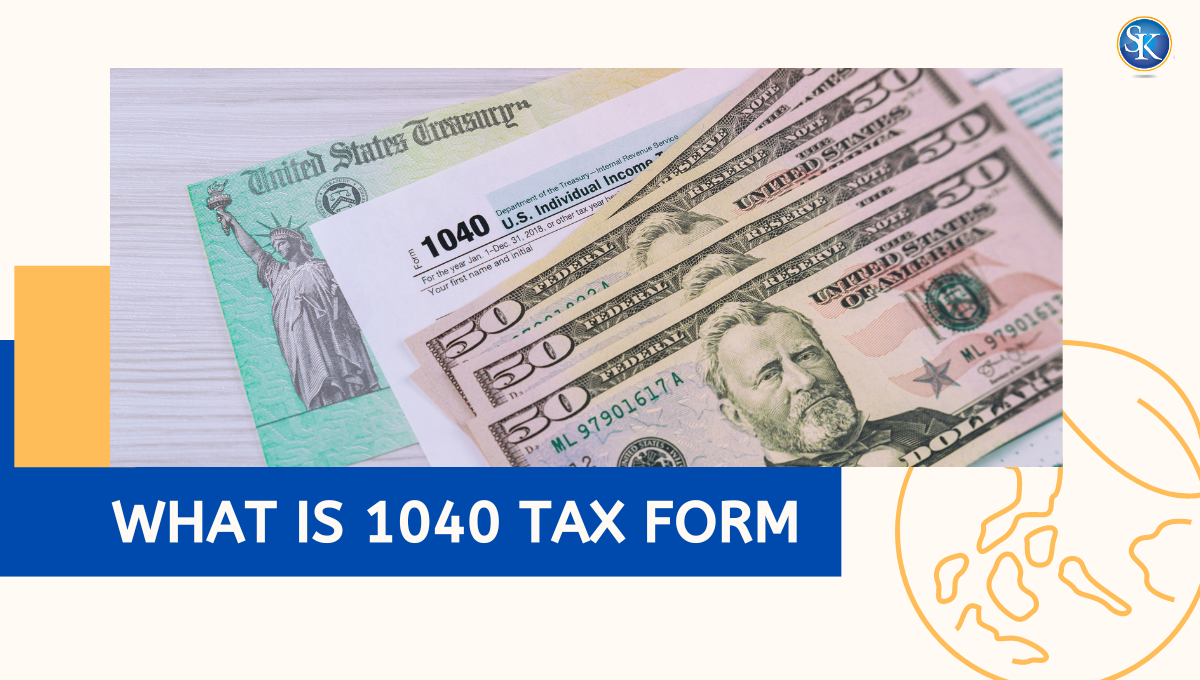
1040 Tax Form: What Is It and How Does It Work?
When it comes to filing federal income taxes in the United States, the 1040 tax form is essential for individuals. This standard Internal Revenue Service (IRS) form is where taxpayers declare their annual income, which determines whether additional taxes are owed or if a refund is due. Here, we explore Form 1040 in detail, including its variants, requirements, and key takeaways for effective tax management.
What is a 1040 tax form?
The 1040 tax form is the primary document used by individual taxpayers to file their taxes with the IRS each year. It serves multiple functions, chiefly among them to report one’s income from various sources such as wages, salaries, dividends, capital gains, and other types of taxable income. In addition to income, taxpayers must also include personal information on Form 1040, such as their name, address, Social Security number, and details regarding dependents. This form is crucial because it determines whether additional taxes are due or if the taxpayer will receive a refund. The versatility of Form 1040 also accommodates various tax situations through supplemental forms, making it adaptable to a wide range of individual financial scenarios.
Learn more about the W2 form
1040 Tax Form Changes
Over the past six years, the 1040 tax form has undergone several significant changes to adapt to evolving socio-economic conditions and tax legislation. These modifications aim to simplify the process while ensuring that the form remains relevant in today's dynamic financial environment. Below is an overview of these changes and their impacts on taxpayers:
|
Year |
Changes in the 1040 Tax Form |
Impact on Taxpayers |
|
2019 |
Simplification of the form layout |
Made it easier for taxpayers to understand and complete |
|
2020 |
Introduction of new fields for cryptocurrency |
Adapted to emerging financial trends |
|
2021 |
Adjustments for COVID-19-related distributions |
Facilitated easier declaration of pandemic-related financial aid |
|
2022 |
Updates for increased standard deductions |
Benefited taxpayers by reducing taxable income |
|
2023 |
Inclusion of additional digital asset questions |
Increased scrutiny on digital investments |
|
2024 |
Enhanced support for green energy credits |
Encouraged investment in renewable resources |
These updates reflect the IRS's efforts to keep pace with changing economic realities and ensure that taxpayers have the necessary tools to report their income accurately.
Pricing Trends for 1040 Tax Form Preparation
The cost of preparing a 1040 tax form has been on an upward trend, largely due to the increasing complexity of tax laws and the need for professional assistance to navigate them. Below is a table depicting the average preparation costs over the last six years:
|
Year |
Average Preparation Cost |
|
2019 |
$176 |
|
2020 |
$184 |
|
2021 |
$199 |
|
2022 |
$211 |
|
2023 |
$220 |
|
2024 |
$230 |
The rising costs illustrate the growing demand for tax preparation services and the enhanced complexity involved in filing accurate returns. This trend underscores the importance of understanding tax requirements and potentially seeking professional advice to ensure compliance and optimize financial outcomes.
Who Can File Form 1040?
Essentially, every U.S. taxpayer who earns income over a specified threshold is required to file Form 1040 by April 15 of each year, unless an extension is granted. This requirement spans all demographics, including self-employed individuals, employees, and even retirees who continue to receive income through pensions or investments. The criteria for who must file are primarily determined by income levels, which vary based on age and filing status, ensuring that taxpayers contribute appropriately to federal revenues based on their earnings.
2023 Gross Income Thresholds (Filed in 2024)
For the tax year 2023, individuals must file a tax return if their gross income exceeds the following thresholds based on their filing status:
|
Filing Status |
Gross Income |
|
Single |
$13,850 |
|
Married Filing Jointly or Qualifying Widow(er) |
$27,700 |
|
Head of Household |
$20,800 |
2024 Gross Income Thresholds (Filed in 2025)
Looking ahead, the income thresholds for filing a tax return in 2025 for the 2024 tax year are projected to increase slightly:
|
Filing Status |
Gross Income |
|
Single |
$14,600 |
|
Married Filing Jointly or Qualifying Widow(er) |
$29,200 |
|
Head of Household |
$21,900 |
How to File Form 1040
Filing Form 1040 can be done either electronically through the IRS e-file system or by mailing a paper form. The electronic method is generally faster and reduces the risk of errors in processing. Taxpayers will need to gather all necessary documentation such as W-2s, 1099s, and records of any eligible deductions or credits before filling out the form. Additionally, the form allows taxpayers to decide whether to contribute $3 to the presidential election campaign fund.
Types of Form 1040
The Internal Revenue Service (IRS) provides various versions of Form 1040 to cater to the specific needs of different taxpayers. Each variant is designed to address particular circumstances, ensuring that individuals can report their financial situation accurately and comply with U.S. tax laws efficiently. Here are the details on each variant:
Form 1040-NR: Non-Resident Aliens
Form 1040-NR is specifically tailored for non-resident aliens who are engaged in business or trade in the United States or have received income from U.S. sources during the tax year. This form ensures that non-residents comply with U.S. tax laws on income that is effectively connected with their business activities in the United States. It includes specific sections for declaring income such as wages, tips, scholarship and fellowship grants, dividends, and interest from U.S. sources.
Form 1040-SR: Seniors
Introduced to simplify tax filing for older adults, Form 1040-SR is available for taxpayers who are 65 years or older. It features a larger font size and a clearer layout to improve readability and ease of use. The content of Form 1040-SR is similar to the standard Form 1040, but it includes a chart for calculating a higher standard deduction amount, acknowledging the financial situations typical among retirees. This form can be used by seniors whether they are filing individually or jointly, and it includes the option to report income from pensions, IRAs, and Social Security benefits.
Form 1040-ES: Estimated Tax for Individuals
Form 1040-ES is used by taxpayers, including self-employed individuals and freelancers, to calculate and pay their estimated quarterly taxes. This is essential for earners whose income does not undergo regular withholding by employers. This includes income from self-employment, interest, dividends, alimony, rent, gains from the sale of assets, prizes, and awards. Form 1040-ES helps these taxpayers avoid underpayment penalties by assisting them in calculating the correct amount to pay each quarter, ensuring they meet their tax obligations throughout the year.
Form 1040-X: Amended U.S. Individual Income Tax Return
If a taxpayer discovers errors or omissions after their tax return has been filed, Form 1040-X is used to make corrections. This form is critical for maintaining accuracy and compliance with tax laws. It can be used to correct previously filed Forms 1040, 1040-A, 1040-EZ, 1040-NR, and 1040-NR EZ. The 1040-X allows taxpayers to change previously reported figures, such as filing status, number of dependents, total income, deductions, and credits. It is essential to ensure that taxpayers can adjust their contributions or refunds as needed based on accurate financial information.
Understanding Which Forms to Use
Choosing the correct form is crucial for correct tax reporting. Taxpayers need to evaluate their specific circumstances, such as their resident status, age, or whether they need to amend a previous return. This ensures that they are using the appropriate form that matches their personal and financial situation, leading to a smoother and more accurate tax filing process.
Each variant of Form 1040 is designed to streamline the tax filing process for different groups of taxpayers, making it easier to fulfill their fiscal responsibilities while maximizing potential benefits under U.S. tax law.
Standard Deductions on Form 1040
The standard deduction reduces the amount of income that is subject to federal taxation, depending on one's filing status. For example, for the tax year 2023, the standard deduction for single filers is $13,850, which increases to $14,600 for the 2024 tax year. These deductions are critical as they simplify the tax preparation process by eliminating the need for many taxpayers to itemize deductions.
|
Filing Status |
2023 |
2024 |
|
Single or Married Filing Separately |
$13,850 |
$14,600 |
|
Married Filing Jointly or Qualifying Widow(er) |
$27,700 |
$29,200 |
|
Head of Household |
$20,800 |
$21,900 |
Additional Schedules
Depending on the taxpayer's circumstances, various additional schedules may be required with Form 1040 to provide further detail on their financial situation:
-
Schedule A (Itemized Deductions):
This schedule allows taxpayers to itemize deductions rather than taking the standard deduction. Deductions can include mortgage interest, state and local taxes, charitable contributions, and medical expenses that exceed a certain threshold.
-
Schedule B (Interest and Ordinary Dividends):
Required if a taxpayer received more than $1,500 in interest or ordinary dividends during the tax year. It helps detail the sources of interest or dividend income.
-
Schedule C (Profit or Loss from Business):
Utilized by self-employed individuals or freelancers to report profits or losses from their business operations. It includes income received, as well as allowable expenses like home office deductions, supplies, and other business-related expenses.
-
Schedule D (Capital Gains and Losses):
Used to report the sale or exchange of assets that may result in capital gains or losses. It is crucial for tracking investment performance and tax liability associated with investments.
-
Schedule E (Supplemental Income and Loss):
For reporting income from rental properties, royalties, partnerships, S corporations, estates, trusts, and residual interests in REMICs.
-
Schedule SE (Self-Employment Tax):
Required for anyone who makes $400 or more from self-employment. This schedule calculates the tax due on net earnings from self-employment, including Social Security and Medicare taxes.
Each of these schedules allows for a more detailed financial disclosure and helps ensure that taxpayers meet their full tax obligations.
Conclusion
The 1040 tax form is fundamental to the U.S. tax system, and crucial for all taxpayers to understand. By keeping abreast of the latest changes, requirements, and thresholds, taxpayers can ensure they comply effectively with tax laws and optimize their financial outcomes. Always consult with a tax professional to ensure accuracy and to leverage all possible tax benefits.
FAQs
What is Form 1040 used for?
Form 1040 is the standard IRS form that individual taxpayers use to file their annual income tax returns. It collects information about the taxpayer's earnings, allowable deductions, credits, and other important financial data to determine the amount of federal income tax they owe for the year. This form is essential for assessing personal tax liability or determining eligibility for a tax refund.
Who needs to file Form 1040?
Any individual who has earned income that exceeds specific thresholds, which vary based on filing status and age, must file Form 1040. This includes wages, salaries, bonuses, self-employed income, and other forms of earnings. The requirement to file is also influenced by factors like whether you qualify for certain credits or owe special taxes.
What are the key changes to Form 1040 for the current tax year?
Each tax year can bring changes to Form 1040 based on new tax laws or IRS updates. Recent updates might include changes to standard deduction amounts, the introduction of new tax credits or adjustments for inflation. Taxpayers should review the latest IRS guidelines or consult with a tax professional to understand these changes and how they might affect their tax filings.
How can I file Form 1040?
Taxpayers can file Form 1040 electronically using the IRS e-file system, which is the fastest method and often results in quicker processing of refunds. Alternatively, you can manually fill out a paper form and mail it to the IRS. Many people also choose to use tax preparation software, which can help navigate the complexities of tax laws and ensure the form is filled out correctly.
When is Form 1040 due?
The typical deadline for filing Form 1040 is April 15th of each year. If this date falls on a weekend or holiday, the due date is extended to the next business day. It's important to note that taxpayers who need more time can request an extension, which gives them until October 15th to file their return. However, an extension to file does not extend the time to pay any taxes owed.
What happens if I make a mistake on Form 1040?
If you discover an error after submitting your Form 1040, you can correct it by filing Form 1040-X, the Amended U.S. Individual Income Tax Return. This form is used to make changes to your previously filed income tax return, including changes to your income, deductions, or credits. It's important to file this form as soon as you notice a mistake to avoid potential interest and penalties.
Can I file Form 1040 if I'm a non-resident?
Non-resident aliens who have earned income from U.S. sources or were engaged in a business in the U.S. during the tax year should file Form 1040-NR. This form accommodates different types of income and deductions that are applicable to non-residents, helping ensure that they comply with U.S. tax laws.
What are the consequences of not filing Form 1040?
Failing to file Form 1040 can result in significant penalties and interest charges from the IRS, especially if you owe taxes. Additionally, the IRS may file a substitute return on your behalf, which might not take advantage of all eligible deductions and credits, potentially leading to a higher tax liability. It's crucial to file even if you can't pay to minimize additional penalties.
How do I know if I should itemize deductions or take the standard deduction on Form 1040?
Whether to itemize deductions or take the standard deduction depends on which option provides the greater tax benefit. You should itemize deductions if the total of your allowable itemized expenses exceeds the standard deduction for your filing status. Common itemized deductions include mortgage interest, real estate taxes, medical expenses exceeding a certain threshold of your income, and charitable contributions. Comparing these figures before filing can lead to substantial tax savings.
What should I do if I can't pay the full amount owed on Form 1040 by the deadline?
If you're unable to pay the full tax liability by the deadline, you should still file Form 1040 to avoid a failure-to-file penalty. Contact the IRS to set up a payment plan, known as an installment agreement, which allows you to pay your tax debt over time with monthly payments. This can help manage your financial burden while staying compliant with tax laws.
Follow SKFinancial on Facebook / Twitter / Linkedin / Youtube for updates.








